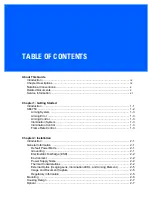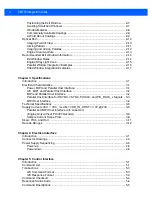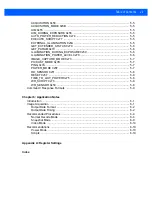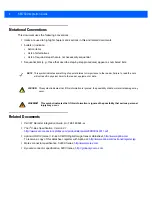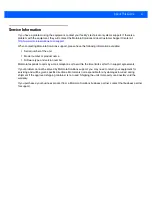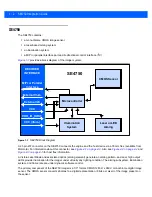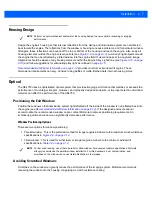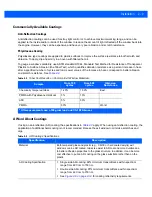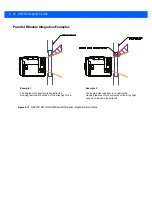
2 - 2
SE4750 Integration Guide
Electrostatic Discharge (ESD)
Use care when handling this component and apply standard ESD handling procedures such as using grounding
wrist straps and handling in a properly grounded work area.
Environment
The engine and decoder must be sufficiently enclosed to prevent dust from gathering on the aiming element,
imaging lens, and illumination system LEDs. Dust and other external contaminants eventually degrade engine
performance. Motorola does not guarantee performance of the SE4750 when used in an exposed application.
Power Supply Noise
For reliable operation a low-noise power supply is required. Pay proper attention to power supply quality and
testing to ensure the best possible performance from the SE4750. In bar code applications, up to 100 mV
peak-to-peak noise is acceptable on all three power input pins (10 Hz to 100 kHz). For image capture applications,
power supply noise for VCC must be limited to 30 mV (peak-to-peak), across the same frequency range.
Thermal Considerations
The SE4750 engine includes several high-power components (e.g., microcontroller, sensor, LEDs) that dissipate
heat during operation. The chassis temperature can reach as high as 72°C when the engine is running at 54
frames per second with full illumination and aiming on. These extreme conditions can increase sensor noise,
degrade image quality, and impact the laser diode's longevity. Use care when designing the SE4750 for integration
into the target application.
As a protective measure for the laser diode, at extreme temperatures the SE4750 first shuts off the laser and dims
illumination (at 68°C chassis temperature). Illumination shuts off at 72°C. As the engine temperature returns to
normal levels the laser and illumination power returns to nominal values.
In a thermal chamber with zero air flow and no heat sink attached, the thermal dissipation of the SE4750 engine
can be simplified as the lumped capacitance thermal model shown in
. The parameters are listed below.
•
P
engine
: The total power consumption of the SE4750 engine (W)
•
T
engine_chassis
: The SE4750 chassis temperature (K)
•
T
ambient
: The ambient temperature (K)
•
R
t_conv
: The thermal resistance between the SE4750 engine and the ambient through natural convection
(reference: 38 K/W)
•
C
engine
: The thermal capacity of the SE4750 engine (reference: 9.2 Joule/K)
•
T
thermal_constant
: The thermal time constant of SE4750 engine (reference: 350 sec),
which equals R
t_conv
* C
engine
Содержание SE4750
Страница 1: ...SE4750 INTEGRATION GUIDE ...
Страница 2: ......
Страница 3: ...SE4750 INTEGRATION GUIDE 72E 171726 01 Revision A November 2013 ...
Страница 6: ...iv SE4750 Integration Guide ...
Страница 10: ...viii SE4750 Integration Guide ...
Страница 14: ...xii SE4750 Integration Guide ...
Страница 18: ...1 4 SE4750 Integration Guide ...
Страница 29: ...Installation 2 11 Aiming Pattern Figure 2 6 SE4750 SR LSR AIM Optical Path Aiming Pattern ...
Страница 36: ...2 18 SE4750 Integration Guide ...
Страница 46: ...3 10 SE4750 Integration Guide Figure 3 3 VCC_ILLUM Current Figure 3 4 VDD_IO Host Current Parallel Version ...
Страница 53: ...Electrical Interface 4 5 Figure 4 3 Parallel Host Flex p n 15 171522 xx ...
Страница 66: ...5 12 SE4750 Integration Guide ...
Страница 78: ...A 2 SE4750 Integration Guide ...
Страница 82: ...Index 4 SE4750 Integration Guide ...
Страница 84: ......
Страница 85: ......


